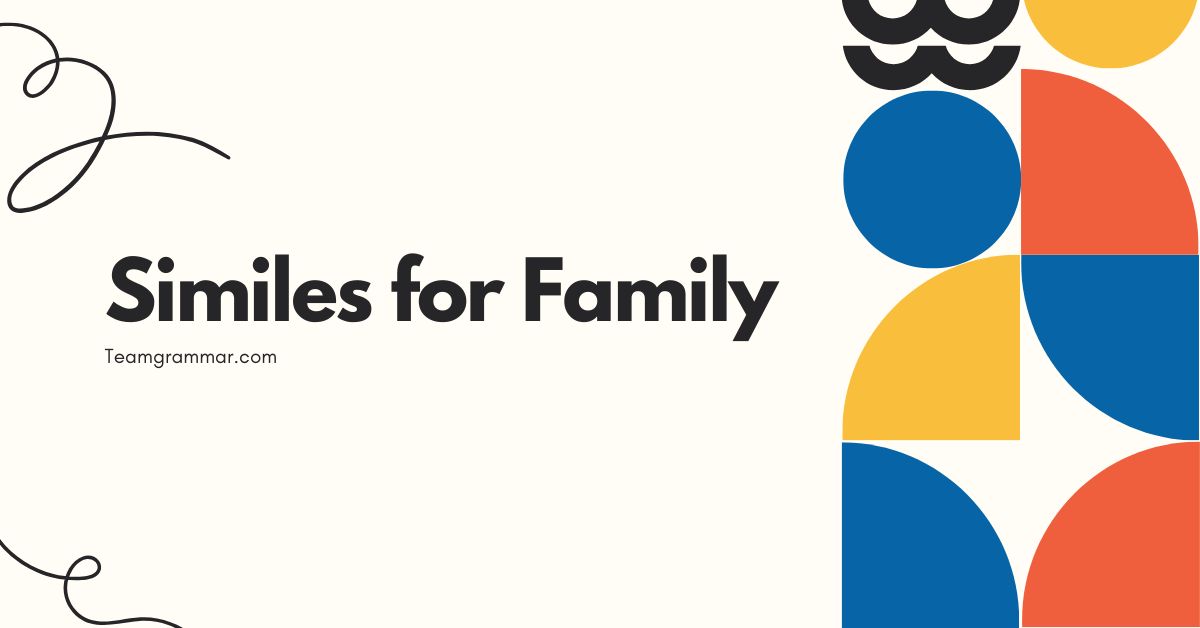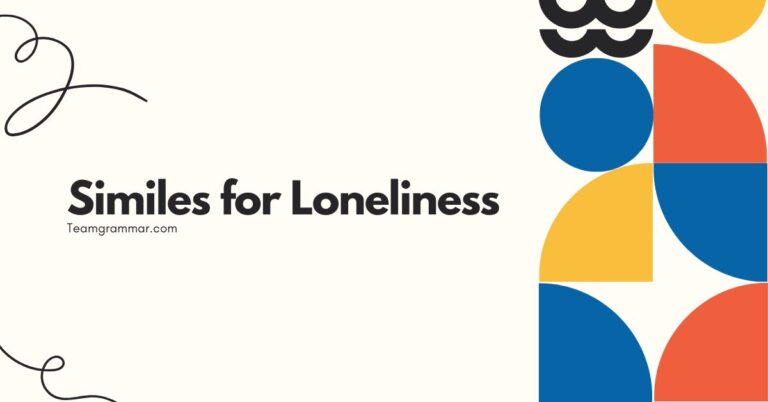43 Similes for Family: A Comprehensive Guide to Figurative Language
Understanding similes is crucial for enhancing your descriptive abilities and adding color to your language. When writing or speaking about family, similes can bring depth and emotion to your descriptions, making them more relatable and vivid.
This article provides a detailed exploration of similes specifically tailored for describing family members and relationships. Whether you’re a student, writer, or language enthusiast, this guide will equip you with the knowledge and tools to use similes effectively in your descriptions of family.
Table of Contents
- Introduction
- Definition of Simile
- Structural Breakdown of Similes
- Types of Similes
- Examples of Similes for Family
- Usage Rules for Similes
- Common Mistakes When Using Similes
- Practice Exercises
- Advanced Topics in Similes
- Frequently Asked Questions
- Conclusion
Definition of Simile
A simile is a figure of speech that compares two unlike things using the words “like” or “as.” The purpose of a simile is to create a vivid image or convey a specific quality by associating it with something familiar. Similes help to make descriptions more engaging and understandable by drawing parallels between different concepts.
In the context of family, similes can be used to describe personalities, relationships, or shared experiences. For example, saying “My brother is as stubborn as a mule” uses a simile to highlight the brother’s stubbornness by comparing it to the well-known stubbornness of a mule.
This comparison makes the description more impactful and memorable.
Classification of Similes
Similes are classified as a type of figurative language, specifically under the umbrella of comparisons. Figurative language deviates from the literal meaning of words to create a more artistic or impactful effect.
Other forms of comparison include metaphors, analogies, and personification; however, similes are unique due to their explicit use of “like” or “as.”
Function of Similes
The primary function of a simile is to enhance description by creating a clearer, more relatable image. By comparing an abstract concept or unfamiliar object to something familiar, similes make it easier for the audience to understand and visualize the intended meaning.
In describing family members, similes can evoke emotions, highlight personality traits, and create a deeper connection between the speaker and the audience.
Contexts for Using Similes
Similes are versatile and can be used in various contexts, including literature, poetry, everyday conversation, and formal writing. In literature, similes add depth and imagery to the narrative.
In everyday conversation, they make descriptions more colorful and engaging. In formal writing, similes can make complex ideas more accessible to the reader.
When describing family, similes can be used in anecdotes, personal essays, or even eulogies to paint a vivid picture of the individuals being described.
Structural Breakdown of Similes
A simile consists of three main components: the subject, the comparison word (“like” or “as”), and the object of comparison. Understanding these components is essential for constructing effective and meaningful similes.
- Subject: The person, thing, or idea being described. In the context of family, this would be a family member or a family relationship.
- Comparison Word: The word “like” or “as” that explicitly indicates a comparison.
- Object of Comparison: The thing to which the subject is being compared. This should be something familiar or easily understood by the audience.
For example, in the simile “My mother is as warm as the sun,” “My mother” is the subject, “as” is the comparison word, and “the sun” is the object of comparison. The simile conveys the idea that the mother is warm and nurturing by comparing her to the sun.
Patterns and Rules
The basic pattern of a simile is:Subject + Comparison Word + Object of Comparison. The comparison should be logical and relevant to the characteristic being described.
The object of comparison should be easily recognizable and evoke the desired image or emotion.
While the most common structure involves “like” or “as,” variations can include using phrases such as “similar to” or “resembles.” However, these variations are less common and may not always be considered strict similes.
Types of Similes
Similes can be categorized based on the type of comparison they make or the effect they create. While there aren’t strict classifications, understanding the different types can help you choose the most effective simile for your purpose.
Descriptive Similes
Descriptive similes focus on physical or observable characteristics. These similes paint a visual picture and often appeal to the senses.
Example: “My grandfather’s hands were as rough as sandpaper.” This simile describes the texture of the grandfather’s hands, creating a tactile image in the reader’s mind.
Emotional Similes
Emotional similes convey feelings or emotional states by comparing them to something that evokes a similar emotion. These similes help to express complex feelings in a relatable way.
Example: “Her grief was like a heavy weight on her chest.” This simile conveys the feeling of grief by comparing it to the physical sensation of a heavy weight, making the emotion more tangible.
Behavioral Similes
Behavioral similes describe actions or behaviors by comparing them to familiar actions or behaviors. These similes help to illustrate how someone acts or behaves in a particular situation.
Example: “My sister gossips like a flock of magpies.” This simile compares the sister’s gossiping to the chattering of magpies, highlighting the incessant and lively nature of her gossip.
Examples of Similes for Family
Here are several examples of similes that can be used to describe family members and relationships, categorized for clarity.
Similes for Describing Mothers
Mothers often play a central role in the family, and similes can help capture their nurturing, strength, and love.
The following table provides examples of similes for describing mothers, highlighting various aspects of their personality and role within the family.
| Simile | Explanation |
|---|---|
| My mother’s love is like a warm blanket on a cold day. | Describes the comforting and nurturing nature of the mother’s love. |
| She is as strong as an oak tree, weathering every storm. | Highlights the mother’s resilience and ability to overcome challenges. |
| Her advice is like a compass, always guiding me in the right direction. | Illustrates the mother’s wisdom and guidance. |
| My mother is as patient as a saint. | Emphasizes the mother’s endless patience. |
| She is as busy as a bee, always taking care of everyone. | Describes the mother’s constant activity and care for her family. |
| Her laughter is like music to my ears. | Describes the pleasant and joyful sound of her laughter. |
| She is as gentle as a lamb with her children. | Illustrates the mother’s gentleness and tenderness. |
| My mother’s hug is like coming home. | Conveys the feeling of comfort and security associated with her hug. |
| She is as wise as an owl, always knowing what to do. | Highlights the mother’s wisdom and knowledge. |
| Her voice is like a calming stream, soothing my worries. | Describes the calming and reassuring effect of her voice. |
| She is as fierce as a lioness when protecting her family. | Emphasizes the mother’s protective nature. |
| My mother’s smile is like sunshine on a cloudy day. | Describes the uplifting and cheerful effect of her smile. |
| She is as dependable as the sunrise. | Illustrates the mother’s reliability and consistency. |
| Her scolding is like a bitter medicine, necessary but unpleasant. | Conveys the idea that her reprimands are for one’s own good. |
| She is as quick as a whip when responding to a crisis. | Highlights the mother’s swift and decisive action in emergencies. |
| My mother’s love is like a lighthouse, guiding me through darkness. | Describes the guiding and protective nature of her love. |
| She is as nurturing as a garden, helping us grow. | Illustrates the mother’s role in fostering growth and development. |
| Her stories are like a window to the past. | Conveys the idea that her stories offer insights into the family’s history. |
| She is as graceful as a swan, even under pressure. | Highlights the mother’s poise and elegance. |
| My mother’s strength is like a mountain, unshakeable and enduring. | Describes her unwavering strength and resilience. |
| She is as resourceful as a Swiss Army knife, always finding a solution. | Illustrates her ability to solve problems and find creative solutions. |
| Her forgiveness is like a gentle rain, washing away our mistakes. | Conveys the idea that her forgiveness is cleansing and restorative. |
| She is as vigilant as a hawk, always watching over her children. | Emphasizes the mother’s attentiveness and care. |
Similes for Describing Fathers
Fathers often represent strength, guidance, and protection within the family. Similes can capture these qualities and more.
The following table provides examples of similes for describing fathers, highlighting various aspects of their personality and role within the family.
| Simile | Explanation |
|---|---|
| My father is as solid as a rock, always there for me. | Describes the father’s reliability and unwavering support. |
| He is as wise as Yoda, always offering insightful advice. | Highlights the father’s wisdom and insightful guidance. |
| His laughter is like a booming thunder, filling the room with joy. | Describes the loud and joyful sound of his laughter. |
| My father is as brave as a lion, facing any challenge head-on. | Emphasizes the father’s courage and bravery. |
| He is as patient as a fisherman, waiting for the perfect moment. | Illustrates the father’s patience and perseverance. |
| His stories are like adventures, taking me to faraway lands. | Conveys the idea that his stories are exciting and imaginative. |
| He is as strong as an ox, able to handle any task. | Highlights the father’s physical strength and capability. |
| My father’s guidance is like a map, helping me navigate life’s journey. | Describes the father’s role in providing direction and support. |
| He is as calm as a still lake, even in the midst of chaos. | Emphasizes the father’s ability to remain calm and composed. |
| His love is like a shield, protecting me from harm. | Describes the protective and caring nature of his love. |
| He is as dependable as the North Star, always a constant presence. | Illustrates the father’s reliability and consistency. |
| My father’s handshake is as firm as iron. | Describes the strength and resolve in his handshake. |
| He is as observant as a hawk, noticing every detail. | Highlights the father’s attentiveness and awareness. |
| His advice is like a well-worn tool, always reliable and effective. | Conveys the idea that his advice is practical and trustworthy. |
| He is as steady as a mountain, providing a sense of security. | Emphasizes the father’s stability and strength. |
| My father’s wisdom is like an ancient tree, rooted in experience. | Describes the depth and value of his wisdom. |
| He is as resilient as bamboo, bending but never breaking. | Illustrates the father’s ability to bounce back from adversity. |
| His support is like a strong bridge, helping me cross difficult waters. | Conveys the idea that his support is essential for overcoming challenges. |
| He is as generous as Santa Claus, always giving to others. | Highlights the father’s generosity and kindness. |
| My father’s discipline is like a sculptor’s chisel, shaping me into a better person. | Describes the formative influence of his discipline. |
| He is as resourceful as a survivalist, always finding a way to make things work. | Illustrates his ability to solve problems and adapt to challenges. |
| His forgiveness is like a clean slate, allowing us to start anew. | Conveys the idea that his forgiveness is refreshing and restorative. |
| He is as dedicated as a watchmaker, meticulously attending to every detail. | Highlights the father’s diligence and attention to detail. |
| My father’s love is like a warm fire, providing comfort and warmth. | Describes the comforting and nurturing nature of the father’s love. |
Similes for Describing Siblings
Siblings share a unique bond, often filled with both camaraderie and rivalry. Similes can capture the complexities of these relationships.
The following table provides examples of similes for describing siblings, highlighting various aspects of their personalities and relationships.
| Simile | Explanation |
|---|---|
| My brother is as annoying as a mosquito, always buzzing around. | Describes the brother’s irritating and persistent behavior. |
| She is as protective as a mother bear, always looking out for me. | Highlights the sister’s protective nature. |
| Our fights are like a thunderstorm, loud and intense but quickly over. | Describes the volatile but short-lived nature of their arguments. |
| My sister is as stubborn as a mule, never backing down from a fight. | Emphasizes the sister’s stubbornness and determination. |
| He is as competitive as an athlete, always trying to win. | Illustrates the brother’s competitive spirit. |
| Our bond is like a strong rope, unbreakable and enduring. | Describes the strength and resilience of their relationship. |
| She is as gossipy as a flock of hens, always sharing the latest news. | Highlights the sister’s talkative and gossipy nature. |
| My brother is as clumsy as a newborn giraffe, always tripping over things. | Describes the brother’s awkwardness and lack of coordination. |
| He is as loyal as a dog, always standing by my side. | Emphasizes the brother’s loyalty and support. |
| Our childhood memories are like a treasure chest, filled with precious moments. | Describes the value and significance of their shared memories. |
| She is as mischievous as a gremlin, always playing pranks. | Highlights the sister’s playful and mischievous nature. |
| My brother is as lazy as a sloth, never wanting to do anything. | Describes the brother’s lack of motivation and energy. |
| He is as supportive as a crutch, always helping me when I’m down. | Illustrates the brother’s supportive and helpful nature. |
| Our rivalry is like a tennis match, constantly going back and forth. | Describes the ongoing competition and back-and-forth nature of their rivalry. |
| She is as quick-witted as a comedian, always making us laugh. | Highlights the sister’s sense of humor and quick thinking. |
| My brother is as messy as a tornado, leaving a trail of chaos wherever he goes. | Describes the brother’s disorganization and untidiness. |
| He is as reliable as a Swiss watch, always there when I need him. | Emphasizes the brother’s dependability and trustworthiness. |
| Our connection is like a secret language, only understood by us. | Conveys the idea that their relationship is unique and deeply connected. |
| She is as dramatic as a soap opera star, always creating a scene. | Highlights the sister’s tendency to exaggerate and create drama. |
| My brother is as forgetful as a goldfish, always forgetting important things. | Describes the brother’s poor memory and absentmindedness. |
| He is as generous as a philanthropist, always giving to others. | Illustrates the brother’s generosity and kindness. |
| Our arguments are like a broken record, repeating the same issues over and over. | Conveys the idea that their arguments are repetitive and unresolved. |
| She is as organized as a librarian, always keeping everything in its place. | Highlights the sister’s meticulous organization and attention to detail. |
| My brother is as opinionated as a pundit, always sharing his views. | Describes the brother’s strong opinions and willingness to express them. |
Usage Rules for Similes
Using similes effectively requires adherence to certain rules to ensure clarity and impact. These rules cover the choice of comparison, the context of usage, and the avoidance of clichés.
- Choose Relevant Comparisons: The object of comparison should be relevant to the characteristic being described. A random or illogical comparison will confuse the audience.
- Avoid Clichés: Overused similes lose their impact. Strive for originality to make your descriptions more engaging.
- Consider the Audience: The object of comparison should be familiar to your audience. A comparison that is obscure or unfamiliar will not be effective.
- Maintain Consistency: Ensure that the simile aligns with the overall tone and style of your writing.
Exceptions and Special Cases
While the basic rules of simile usage are straightforward, there are some exceptions and special cases to consider. For example, sometimes a slightly unexpected comparison can be effective if it is done intentionally and serves a specific purpose.
Additionally, cultural context can influence the effectiveness of a simile. A comparison that is well-understood in one culture may not be as effective in another.
Always consider your audience when choosing similes.
Common Mistakes When Using Similes
Several common mistakes can diminish the effectiveness of similes. Being aware of these mistakes can help you avoid them and use similes more effectively.
- Using Clichés: Overused similes like “as busy as a bee” or “as strong as an ox” lack originality and impact.
- Illogical Comparisons: Comparing unrelated things that do not share a common characteristic.
- Overcomplicating Similes: Using overly complex language that obscures the meaning of the simile.
- Misusing “Like” and “As”: Confusing the usage of “like” and “as” in different contexts.
Here’s a table illustrating common mistakes with similes and corrections:
| Incorrect | Correct | Explanation |
|---|---|---|
| My brother is as busy as a bee. | My brother is as busy as a street vendor during rush hour. | Avoid clichés by using more original comparisons. |
| She is as tall as an idea. | She is as tall as a basketball player. | Ensure the comparison is logical and relatable. |
| His love was like a convoluted amalgamation of affection and empathy. | His love was like a warm embrace. | Keep the language simple and clear. |
| He acts like he is a king. | He acts as if he is a king. | Use “as if” to describe how someone behaves. |
Practice Exercises
Test your understanding of similes with these practice exercises. Each exercise focuses on different aspects of simile usage.
Exercise 1: Identifying Similes
Identify the similes in the following sentences:
| Question | Answer |
|---|---|
| 1. Her voice was like a soothing melody. | “like a soothing melody” |
| 2. He ran as fast as the wind. | “as fast as the wind” |
| 3. The house stood like a sentinel on the hill. | “like a sentinel” |
| 4. My grandmother is as wise as an owl. | “as wise as an owl” |
| 5. The snow fell like a soft blanket. | “like a soft blanket” |
| 6. My father’s heart is as big as the ocean. | “as big as the ocean” |
| 7. She dances like a dream. | “like a dream” |
| 8. The cake was as light as a feather. | “as light as a feather” |
| 9. Her eyes sparkled like diamonds. | “like diamonds” |
| 10. The baby slept like a log. | “like a log” |
Exercise 2: Completing Similes
Complete the following similes with an appropriate comparison:
| Question | Answer |
|---|---|
| 1. My sister is as funny as __________. | a comedian |
| 2. He eats like __________. | a horse |
| 3. The car was as old as __________. | the hills |
| 4. She sings like __________. | an angel |
| 5. The test was as easy as __________. | pie |
| 6. My brother is as loud as __________. | a rock concert |
| 7. He is as quiet as __________. | a mouse |
| 8. The coffee was as bitter as __________. | medicine |
| 9. She is as graceful as __________. | a swan |
| 10. The line was as long as __________. | forever |
Exercise 3: Creating Similes
Create your own similes to describe the following family members:
| Family Member | Your Simile |
|---|---|
| Grandfather | My grandfather’s stories are like a portal to another time. |
| Aunt | My aunt’s hugs are like a warm fireplace on a winter’s night. |
| Cousin | My cousin’s laughter is as contagious as the common cold. |
| Uncle | My uncle’s advice is as valuable as gold. |
| Grandmother | My grandmother’s cooking is like a taste of heaven. |
| Stepfather | My stepfather’s support is as strong as an oak. |
| Stepmother | My stepmother’s kindness is like a ray of sunshine. |
| Nephew | My nephew is as energetic as a hummingbird. |
| Niece | My niece is as curious as a kitten. |
| Son | My son’s smile is as bright as the sun. |
Advanced Topics in Similes
For advanced learners, exploring the nuances and subtle applications of similes can further enhance their writing and communication skills.
Extended Similes
An extended simile is a simile that is developed over several lines or even a paragraph. This allows for a more detailed and nuanced comparison.
Example: “My father’s love is like a sturdy tree, its roots running deep into the earth, providing unwavering support through every season. Its branches reach high, offering shelter and guidance, and its leaves whisper wisdom in the wind.”
Subverted Similes
A subverted simile is a simile that intentionally defies expectations or creates a surprising comparison. This can be used for comedic effect or to challenge conventional thinking.
Example: “My brother is as graceful as a bull in a china shop.” This simile creates a humorous contrast by comparing the brother to something notoriously clumsy.
Cultural Sensitivity in Similes
When using similes, it’s important to be aware of cultural sensitivities. A comparison that is harmless in one culture may be offensive or misunderstood in another.
Always consider your audience and the potential impact of your words.
Frequently Asked Questions
- What is the difference between a simile and a metaphor?
A simile compares two things using “like” or “as,” while a metaphor directly equates two things without using these words. For example, “My brother is like a bear” (simile) versus “My brother is a bear” (metaphor).
- Can a simile be a cliché?
Yes, overused similes become clichés. To avoid this, strive for originality and create fresh, unique comparisons.
- How do I choose the right object of comparison for a simile?
Choose an object that is relevant to the characteristic you are describing and that is familiar to your audience. The comparison should be logical and evoke the desired image or emotion.
- Are similes only used in writing?
No, similes are used in both writing and speaking. They can add color and impact to everyday conversations as well as formal presentations.
- Can I use more than one simile in a sentence?
While it’s possible, it’s generally best to avoid using too many similes in a single sentence, as it can become cluttered and confusing. Focus on using one or two effective similes.
- How can I improve my simile writing skills?
Practice regularly, read widely to observe how other writers use similes, and seek feedback on your writing. Pay attention to the clarity and impact of your comparisons.
- Is there a limit to how long a simile can be?
While similes are typically concise, they can be extended over several lines or even a paragraph for a more detailed comparison. These are known as extended similes.
- What should I do if I can’t think of a good simile?
Brainstorm different ideas, look for inspiration in nature or everyday life, and consider the specific qualities you want to emphasize. Sometimes, a thesaurus can help you find alternative words or concepts.
- How important is cultural context when using similes?
Cultural context is very important. A simile that works well in one culture may not be effective or even appropriate in another. Always consider your audience and the potential for misunderstanding.
- Are similes appropriate for formal writing?
Yes, similes can be appropriate for formal writing, but they should be used judiciously. Ensure that the similes enhance clarity and do not detract from the overall tone and style of the writing.
Conclusion
Mastering the use of similes can significantly enhance your descriptive writing and communication skills, especially when portraying the complexities and nuances of family relationships. By understanding the structure, types, and usage rules of similes, you can create vivid and engaging descriptions that resonate with your audience.
Remember to choose relevant comparisons, avoid clichés, and consider your audience to maximize the impact of your similes.
Practice is key to developing your simile writing skills. Experiment with different comparisons, seek feedback on your writing, and continue to explore the creative possibilities of figurative language.
With dedication and attention to detail, you can become proficient in using similes to bring your descriptions of family to life.







